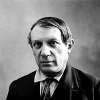Gino
Severini
Severini, a leading Futurist, bridged Italian and French avant-garde movements with his dynamic, fragmented style. If you're looking for Gino Severini original prints and editions for sale or would like to sell, request a complimentary valuation and browse our network's most in-demand works.
Gino Severini art for sale
Discover Gino Severini prints for sale, exclusively available through our private network of collectors. Explore signed and unsigned screenprints, lithographs, digital prints, and rare editioned proof prints by era-defining blue chip artists.
Sell Your Art
with Us
with Us
Join Our Network of Collectors. Buy, Sell and Track Demand
Biography
Severini's artistic journey began in Rome in 1899, where he studied Divisionist techniques under Giacomo Balla alongside Umberto Boccioni. This early training laid the foundation for his future explorations in Futurism and Cubism.
In 1906, Severini moved to Paris, a decision that would profoundly influence his artistic development. Severini's position as a bridge between Italian Futurism and French avant-garde circles made him an important figure in the merging of artistic approaches. His work synthesised the dynamic energy of Futurism with the analytical approach of Cubism, creating a style that set him apart from his contemporaries.
Severini's career reached a significant milestone in 1910 when he became a signatory of the Manifesto Of Futurism, aligning himself with the movement's emphasis on speed, technology, and modernity. However, his time in Paris allowed him to develop a more nuanced approach, incorporating elements of Cubism into his Futurist works.
The artist's most celebrated period came during the 1910s and early 1920s when he produced some of his most iconic works. Paintings such as Dynamic Hieroglyphic Of The Bal Tabarin (1912) exemplify his ability to capture the frenetic energy of modern life through a fragmented, rhythmic style.
In the 1920s, Severini's work took a more classical direction, reflecting a broader 'return to order' in European art. This period saw him explore traditional subjects and techniques, yet he maintained elements of his earlier avant-garde approach. Throughout his career, Severini also made significant contributions to art theory, publishing Du Cubisme Au Classicisme in 1921, which outlined his ideas on the mathematical basis of painting.






















